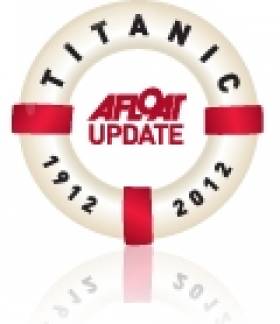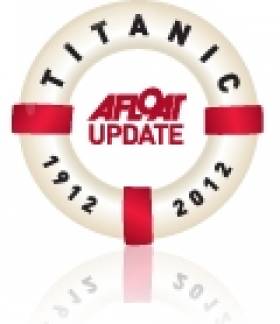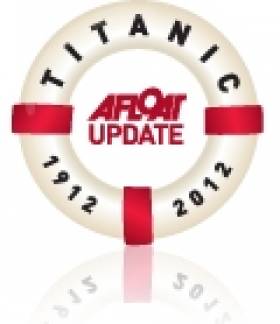Displaying items by tag: Balmoral
A dry-dock at A&P Falmouth has welcomed a 218-meter /1,325 capacity cruise ship which is operated by Fred. Olsen Cruise Lines.
Fred. Olsen cruise ships are regular visitors to Falmouth International Cruise Terminal, which is also operated by A&P. However, this is the first time the company has chosen to send its cruise ships to A&P for ship repair works.
The Balmoral’s programme of works includes steel inserts, ship side valves, tunnel thruster overhaul and underwater paint.
Eddie Purves, Group Managing Director at A&P Group said: “We are delighted that Fred. Olsen Cruise Lines has chosen to take advantage of A&P Group’s ship repair facilities.”
“A&P Group is the UK”s largest commercial ship repair operation. The combination of our three strategic locations, seven dry docks, fabrication services and wide-reaching skills and capabilities makes our facilities a first-class choice for cruise customers who operate in the UK and beyond.”
“A&P Falmouth is strategically located next to the English Channel and offers full drydocking facilities to medium size cruise ships with excellent on site machining capabilities.
“Falmouth’s International Cruise Terminal is a firm favourite with some of the world’s leading cruise companies, with vessels visiting the port for transit and turnaround calls.
“Our ambition is now to make A&P Falmouth and A&P Tyne a centre of excellence in cruise ship repair, minimising the downtime of customers vessels and enhancing the availability of their fleet.”
David McGinley, CEO said; “It has been fantastic to welcome Fred. Olsen's Balmoral into A&P Falmouth.”
“Contracts such as these help us to sustain our workforce, apprenticeship programme and supply chain which drives prosperity and adds real social value to the South West of England and beyond.
“We are delighted to welcome the MV Balmoral to Falmouth and look forward to developing our partnership with Fred. Olsen.”
Peter Deer, Managing Director at Fred. Olsen Cruise Lines, said: “Our smaller ships regularly call into Falmouth as part of our UK sailings, and it’s a town that we know our guests love to visit with us. “We are really pleased to be expanding this relationship with A&P Falmouth by working with them for a dry dock for our elegant Balmoral, as we get her ready for a return to service with us in early May.
“As a family-run cruise line, we know how important it is to support local communities. By docking in Falmouth, we are pleased to be supporting the local community here and the wider supply chain as Balmoral prepares to welcome her first guests back on board.
“We look forward to an even stronger working relationship with A&P Group both now and in the future.”
Royal Navy Attend Presidential Fleet Review for Cobh Titanic 100
#COBH TITANIC 100 - Following President Michael D. Higgins visit to Cobh to commemorate the centenary call of RMS Titanic to Queenstown, the town yesterday hosted a Naval Service review that included the Royal Navy's HMS Mersey.
The President as supreme commander of the Defence Forces boarded the Naval Service 'flagship' L.E. Eithne which passed the guest-ship, a River class patrol vessel which headed a line of vessels which lay at anchor of Cobh's waterfront, they were the L.E. Aoife, L.E. Aisling and L.E. Niamh
The historic event which marked the pinnacle of the Titanic 100 Cobh centenary week will continue as part of a year-round programme of events. For information visit www.titanic100.ie. On the homepage the L.E. Niamh features again, where on this occasion marine photographer Jehan Ashmore captured the vessel underway as she powered her way at high-speed through a misty Dalkey Sound.
Among the many places throughout Cobh where thousands of tourists have flocked since the Balmoral docked on Monday to retrace the liner's maiden voyage, has been the White Star Line pier.
From this pier were the last passengers to depart Queenstown on board the tenders PS Ireland and PS America to the ill-fated Titanic that struck an ice-berg. On her Irish call 123 passengers were transferred to the Titanic which lay outside Cork Harbour, while 7 passengers disembarked from the liner and headed ashore.
What remains of the pier which is not accessible to the public and is in danger of collapsing, there has been calls to raise funds to save the structure, as previously reported.
Also in attendance during yesterday's historic proceedings, was the excursion passenger tender Spirit if the Isles which is operating on her second season since starting Cork Harbour cruises last year. They run between Cork city quays and downriver along the Lee to Cobh.
In the 1980's the tender then named Ingot ran excursions from Dun Laoghaire Harbour into Dublin Bay and likewise of L.E. Niamh, she too transited Dalkey Sound as part of her sightseeing tours.
- RMS Titanic
- White Star Line
- Cobh Cruise Callers
- Cobh, Cork Harbour
- Cruiseships
- Balmoral
- FredOlsen Cruise Lines
- Titanic Memorial Cruise
- naval service
- LEEithne
- Royal Navy
- HMS Mersey
- President Michael D Higgins
- Queenstown,Ireland
- PS Ireland
- PS America
- Spirit of the Isles
- Cork Harbour Cruises
- Cork Harbour News
- Dalkey Sound
- LE Niamh
- LE Aoife
- LE Aisling
- Cork Harbour
- River Class Patrol vessels
- River Lee
- Irish marine photographers
Titanic Memorial Cruise Heads for Cobh
#TITANIC MEMORIAL CRUISE - Following Balmoral's recent call to Belfast in memory of Titanic, the Fred.Olsen Lines cruiseship returned to Southampton where today she started a 12-night Titanic Memorial Cruise which will follow the White Star Line liner's original itinerary that included calling to Queenstown, now Cobh.
Before Balmoral calls to Cobh tomorrow, she is to pass Cherbourg, where the passenger tender SS Nomadic served the liner that layed anchored offshore. The 101 year-old tender was also built by Harlalnd & Wolff and she is undergoing restoration work in Belfast, to read more about her click HERE.
Likewise to Balmoral's Belfast visit, her arrival to Cobh is the inaugural call for this year's season, though her poignant arrival will be two days short of Titanic's call a century ago on 11th April 1912.
On Titanic's second anchorage at Queenstown, this too required tenders to transfer 123 passengers who embarked from the town's pier and of those only 44 survived the disaster. The timber built pier still exists albeit what survives is in a derelict state. There have been calls to raise funds to save the structure as previously reported.
Along the scenic waterfront passengers can take a tour of the town's new Titanic Experience in the White Star Line building, the Queenstown Heritage Story in the Cobh Hertiage Centre and the walking Titanic Trails.
From Cobh the Balmoral will sail across the Atlantic, arriving at the Titanic site on April 14th/15th - exactly 100 years on from this tragic voyage, where a memorial service will be held to pay tribute to the brave passengers and crew who perished on that fateful night.
The cruise will then continue to Halifax, Nova Scotia, the final resting place of many who were on board, before sailing on to New York, the Titanic's ultimate planned destination.
- White Star Line
- RMS Titanic
- Balmoral
- Fred Olsen Cruise Lines
- Titanic Memorial Cruise
- Cobh Cruise Calls 2012
- Belfast Port
- SS Nomadic
- Titanic's passenger tender
- Cruise ship news
- Cruiseships
- port of Cork
- Cobh Cruise Terminal
- Titanic Trails
- Cobh Heritage Centre
- White Star Line liners
- Queenstown,Ireland
- Harland & Wolff
- Nomadic Charitble Trust
Tours of Titanic’s Tender SS Nomadic
#TITANIC'S TENDER - While all the attention is focused on the R.M.S. Titanic and the newly opened Titanic Belfast visitor experience, the White Star Line passenger tender SS Nomadic is only a stone's throw away from the venue, writes Jehan Ashmore.
Like the liner she was built by Harland & Wolff and her launch took place in 1911. She was commissioned by White Star Line as a 1st and 2nd class passenger tender for Titanic and sister Olympic.
The Nomadic carried out her duties based in Cherbourg, where she transferred passengers to the Titanic on her only call to the Normandy port. As such the vessel which is registered in the French port, is the last surviving White Star Line vessel in the world and the only remaining authentic link to the ill-fated liner.
Decades later, the Nomadic became a floating restaurant on the River Seine in Paris close to the Eiffel Tower, where the venture which started in 1977 remained formore than twenty years.
The ageing vessel faced new safety regulations threatening her fate which ultimately led to her being seized in 2002. She was then offered for sale and then followed a court action for her to be scrapped but a campaign was raised to save the historic vessel which succeeded in her securement.
At 95 years old she was towed by barge back to her builder's birthplace in Belfast in 2006. Now that she is over a century old the vessel is currently undergoing restoration by the SS Nomadic Charitable Trust. She is dry-docked in the Hamilton Dock which adjoins the new iconic landmark of the Titanic Belfast building within the developing Titanic Quarter.
Yesterday 'hard-hat' tours began of the preserved liner tender and it is essential to note that tickets are to be 'pre-booked' with the last tour on 15th April. Daily tours are at 10.30, 12 noon, 2pm and the last tour is 3.30pm. To ensure availability visit: www.nomadicbelfast.com/book-a-tour
For further information about the various visitor attractions and events click the following headings, to be directed to the relevant websites.
The history of the S.S. Nomadic
Titanic Belfast Festival (31 March -22 April)
Titanic Belfast Visitor Experience
Following yesterday's inaugural cruise call to Belfast this year of Balmoral as previously reported the Fred. Olsen Cruise Lines vessel was making a cruise in memory of the liner. To see the list of the other cruiseships calling to the city, click HERE.
- RMS Titanic
- SS Nomadic
- White Star Line
- Nomadic Charitble Trust
- Harland & Wolff
- H&W
- Cherbourg
- White Star Line passenger tenders
- Hamilton Dock, Belfast
- Port of Belfast
- Belfast Lough News
- Cruise ships
- Cruise Liners
- Balmoral
- Fred. Olsen Cruise Lines
- Restaurant river Seine boats
- Titanic Belfast
- Titanic Quater
- Titanic Belfast Festival
- RMS Olympic
Easter Cruisecall to Belfast in Memory of Titanic
#TITANIC – The cruiseship Balmoral not only is the first caller to Belfast for 2012 as previously reported, but her arrival this morning marked more importantly as a cruise in the memory of the R.M.S. Titanic, writes Jehan Ashmore.
Cruise passengers embarked on the Fred. Olsen Cruise Lines ship last Tuesday in Southampton for a mini-cruise which included a call to Liverpool yesterday.
Today passengers where to visit the builders of the White Star Line liner launched a century ago at Harland & Wolff shipyard at Queens Island on the banks of the Lagan.
Adjoining the complex is the Titanic Quarter where the recently opened Titanic Belfast Visitor Experience is making an impression through the iconic landmark, for further details click HERE.




























































